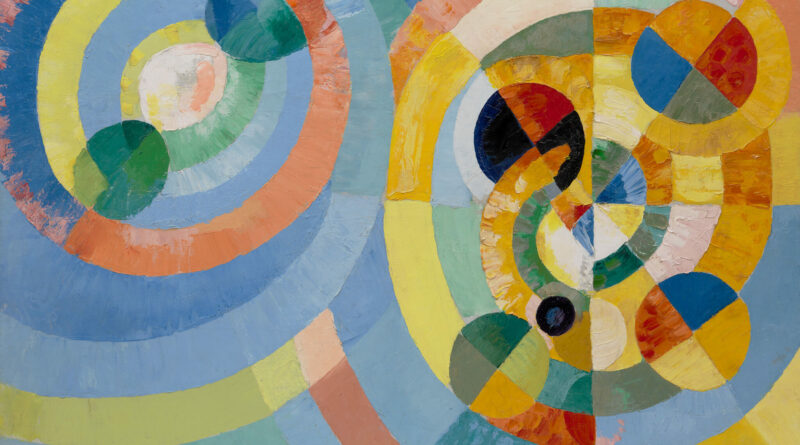The Guggenheim Museum Presents Harmony and Dissonance: Orphism in Paris, 1910–1930
Exhibition: Harmony and Dissonance: Orphism in Paris, 1910–1930
Venue: Solomon R. Guggenheim Museum, 1071 Fifth Avenue, New York
Location: Rotunda Levels 1–5 and High Gallery
Dates: November 8, 2024–March 9, 2025
The Solomon R. Guggenheim Museum will present Harmony and Dissonance: Orphism in Paris, 1910–1930, the first in-depth examination of Orphism, which emerged in Paris among a cosmopolitan group of artists in the early 1910s—when changes brought on by modernity were radically altering notions of time and space. Open from November 8, 2024, to March 9, 2025, the presentation will feature over 80 artworks comprising painting, sculpture, works on paper, and ephemera, installed across five levels of the museum’s spiral rotunda.
The poet Guillaume Apollinaire coined the term “Orphism” in 1912 to describe artists who were moving away from Cubism, toward an abstract, multisensory mode of expression. Apollinaire’s concept referenced the Greek mythological poet and lyre player Orpheus—who swayed nature and challenged death with his song—equating the ephemeral abstraction of his music with Orphism’s transcendent character.
Associated artists such as Robert Delaunay, Sonia Delaunay, František Kupka, and Francis Picabia created kaleidoscopic compositions that captured the simultaneity of modern life. Some investigated chromatic consonances and contrasts in their prismatic works, while others engaged with the rhythms and syncopations of popular music and dance. They drew inspiration from Neo-Impressionism’s color theory and the Blue Rider group’s philosophies. When pushed to its limits, Orphism meant total abstraction.
Alongside the formal harmony and dissonance related to color and sound that underpins Orphist compositions, the exhibition will reveal sociocultural corollaries sparked by transnationalism, or the connections that greater mobility fostered between artists from myriad countries who converged in Paris as well as the tensions that geographic and cultural dislocations could engender.
Harmony and Dissonance will employ Orphism as a generous and elastic category to embrace a range of artists experimenting with abstraction in the early twentieth century. Thus, selected works by Amadeo de Souza-Cardoso, Marc Chagall, Marcel Duchamp, Albert Gleizes, Mainie Jellett, Fernand Léger, Stanton Macdonald-Wright, Morgan Russell, and others will be among those in the presentation. Around a quarter of the exhibition’s works hail from the Guggenheim’s collection, the very body of art that Frank Lloyd Wright designed the museum to house, aptly honoring the building’s 65th anniversary in fall 2024.
Harmony and Dissonance will be accompanied by a comprehensive catalogue that, in tandem with the exhibition, situates Orphism historically, traces its roots, and addresses its multidisciplinary reach. Edited by Vivien Greene, the fully illustrated publication features essays by an international roster of established and emerging scholars from multiple fields including dance, history, literature, and musicology—namely Nell Andrew, Tracey Bashkoff, Gurminder K. Bhogal, Elizabeth Everton, David Max Horowitz, and Effie Rentzou—as well as concise texts that consider specific artists through the Orphist lens contributed by Matthew Affron, Masha Chlenova, Riann Coulter, Joana Cunha Leal, Megan Fontanella, Caitlin Glosser, Bellara Huang, Michael Leja, Anna Liesching, Chitra Ramalingam, and Rachel Silveri.
The conservation of Robert Delaunay’s Eiffel Tower (1911; inscribed 1910) is another example of the commendable scholarly research conducted around this exhibition. The cleaning of this work by the Guggenheim Museum’s conservation team, along with František Kupka’s Divertimento I (1935), has restored the paintings’ subtle yet important color shifts, depth, and sense of movement.
Additionally, the museum will conduct a carbon emission study on Harmony and Dissonance, in accordance with the institution’s commitments to quantify its environmental impact, establish benchmarks and baselines, and ultimately reduce its carbon footprint.
Harmony and Dissonance: Orphism in Paris, 1910–1930 is organized by Tracey Bashkoff, Senior Director of Collections and Senior Curator, and Vivien Greene, Senior Curator, 19th- and Early 20th-Century Art, with the support of Bellara Huang, Curatorial Assistant, Exhibitions.
Programs
Several public programs will be presented at the Guggenheim Museum on the occasion of Harmony and Dissonance beginning in late 2024, including monthly curator-led tours free with admission (starting November 12); a Works & Process Rotunda Dance Party with NYCity Tango Collective during the Member Monday on November 18; the Late Shift on December 2; a three-part online course in color theory starting December 4; and the Fourteenth Annual Robert Rosenblum Lecture, to be given by Juliet Bellow, Associate Professor of Art History at American University, on February 26. Works & Process will present Tango Essence with Pedro Giraudo’s Tango Quartet on November 18 and Ballet Hispánico Instituto Coreográfico, with a focus on tango, on March 1. Furthermore, the museum is partnering with the Leonard A. Lauder Research Center for Modern Art at The Metropolitan Museum of Art on a study day to be hosted at the Guggenheim Museum on February 12. Event details are subject to change. Please visit guggenheim.org/calendar for more information.
Sixth Stanza
During the run of Harmony and Dissonance, the rotunda’s top level will be activated as a space for rest and contemplation. Collectively named Sixth Stanza, the installation will feature two recent museum projects that connect poetry and visual art. For Ekphrasis in Air, the 2024 Guggenheim Poet-in-Residence Meg Day invited six fellow poets to compose original works in American and British Sign Language in response to the Guggenheim’s architecture and permanent collection. Presented in Sixth Stanza as a series of projected videos, these responses highlight the visual artistry that poetry in sign language can bring to the historical lineage of ekphrasis—a literary device that expands and complicates the meaning of a work of art through verbal description. In other bays, excerpts of translated works by Guillaume Apollinaire and Blaise Cendrars, two twentieth-century poets integral to Orphism, will play aloud. Some of these poems will directly elaborate on the art and artists in Harmony and Dissonance. Altogether Sixth Stanza will prompt viewers to slow down, observe, build connections, and consider their own experiences of physically inhabiting the museum and the world.
Support
Lead support for Harmony and Dissonance: Orphism in Paris, 1910-1930 is provided by ALAÏA.
The Leadership Committee is gratefully acknowledged for its generosity, with special thanks to Oded Halahmy Foundation for the Arts, Inc., Natasha and François-Xavier de Mallmann, Judy and Leonard Lauder, Per J. Skarstedt, Peter Bentley Brandt, and Aaron I. Fleischman and Lin Lougheed.
Support is also generously provided by The Kate Cassidy Foundation and The David Berg Foundation.
Additional funding is provided by the Solomon R. Guggenheim Museum’s Collections Council, the Curators Circle, and the International Director’s Council.
This exhibition is supported by an indemnity from the Federal Council on the Arts and the Humanities.
Guggenheim Poet-in-Residence is made possible by Van Cleef & Arpels.
About the Solomon R. Guggenheim Foundation
The Solomon R. Guggenheim Foundation was established in 1937 and is dedicated to promoting the understanding and appreciation of modern and contemporary art through exhibitions, education programs, research initiatives, and publications. The international constellation of museums includes the Solomon R. Guggenheim Museum, New York; the Peggy Guggenheim Collection, Venice; the Guggenheim Museum Bilbao; and the future Guggenheim Abu Dhabi. An architectural icon and “temple of spirit” where radical art and architecture meet, the Solomon R. Guggenheim Museum is now among a group of eight Frank Lloyd Wright structures in the United States recently designated as a UNESCO World Heritage site. To learn more about the museum and the Guggenheim’s activities around the world, visit guggenheim.org.
@Guggenheim
#OrphismGuggenheim

